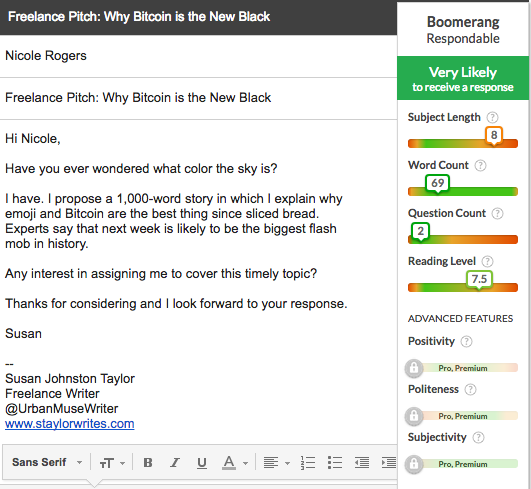B2C Tech
Can AI Really Help You Write Better Emails?
This story was originally published on our sister site, The Freelancer.
Having pitches ignored by busy editors is nothing new to freelancers. Editors receive so many emails every day, and the increasing demands on everyone’s time at publications fighting to stay alive means getting someone’s attention is a real challenge.
So on August 23, when the makers of Boomerang (a Gmail tool that lets you schedule messages to be sent later) launched a new tool called Respondable (which is supposed to help you improve email response rates), I started using it immediately.
Based on data from millions of emails, Respondable uses artificial intelligence to rate the likelihood of an email getting a response. It scores messages based on factors like reading level, subject length, and word count. (Premium features rate messages on politeness, positivity, and other factors, but I used the free version.)
As you revise your email by shortening your subject line or choosing simpler words, you can see the likelihood of a response rate increase.

A tool like this has an obvious appeal to freelancers. However, it doesn’t understand important context like the sender’s relationship to the recipient or the recipient’s individual preferences. Regardless of what I write in an email to my mother, she’ll probably respond in a few days with “Sounds great! Love, Mom”—even if Respondable warns me that I’m writing at a 12+ grade reading level.
On the other hand, even if I draft an email that Respondable deems “very likely to receive a response” and send it to an editor at The New Yorker I’ve never worked with before, I wouldn’t hold my breath.
Suffice to say, Respondable not taking the social context of an email into account left me skeptical, so I decided to put it to the test. I spent one month sending emails without Respondable and then sent every email with the tool the following month.
Obviously, this is an unscientific study. It’s a small sample size and doesn’t control for variables like the quality of different pitches, competition level of the market, or timing of the emails. But my little experiment still led to some interesting results.
Here’s a look at the numbers.
Pre-Respondable: July 23–August 23
I sent 25 emails to editors (19 initial pitches, two letters of introduction, and four follow-up emails). I received seven replies (two responses to follow-ups and five to initial pitches). That’s a 28 percent response rate. About a third of the respondents were editors I’d worked with before. Of those who didn’t respond, all but two were editors I hadn’t worked with before, so I had less expectation of a speedy response anyway.
Post-Respondable: August 24–September 24
I sent 23 emails to editors (14 initial pitches and nine follow-up emails) and I revised every email until Respondable scored it as likely or very likely to get a response. This time, I got 12 responses (three responses to follow-ups and nine to initial pitches. Three replies came from editors I’d worked with before.
That’s a 52 percent response rate, a significant jump from the previous month. However, I wouldn’t give Respondable all the credit. My hunch is that editors are more likely to respond in September when they’re back from vacation and looking to use freelance budgets before the end of the year, which may have also upped my odds.
One thing worth noting is Respondable’s general guidelines. Here are the tool’s four recommendations to users who download the free version:
- Keep the subject length to 3–7 words: I use the format “Freelance Query: [Article Topic]” so this is a tough one, since a third of my word count is already eaten up by “Freelance Query.”
- Limit the body of the email to 50–250 words: I want my pitches to provide enough detail to pique editors’ interest in the topic and also sell them on my credentials, so I tend to push the upper end of this range.
- Ask 1–3 questions in your email: Questions serve as a call to action for the recipient. I typically ask a single question like “May I cover this trend for _____ magazine?”
- Write at a grade 1–7 reading level: Most of my initial email drafts were rated a 12+ grade level, so this is a good reminder to use shorter sentences and simpler words. Even after simplifying my pitches, they tend to fall at the upper end of this range, and I’m okay with that.
These are all good rules to live by, but they’re not enough on their own. Just for fun, I drafted a nonsensical pitch that fit all the above criteria and netted me a “Very Likely to receive a response” rating. I doubt I’d have much luck if I actually sent it.
In the end, I think it’s more important for writers to focus on writing well-developed, interesting pitches than to agonize over the number of questions or the reading level—but Respondable can be a nice reminder to clean up your email before you hit send.
Image by Getty ImagesGet better at your job right now.
Read our monthly newsletter to master content marketing. It’s made for marketers, creators, and everyone in between.





